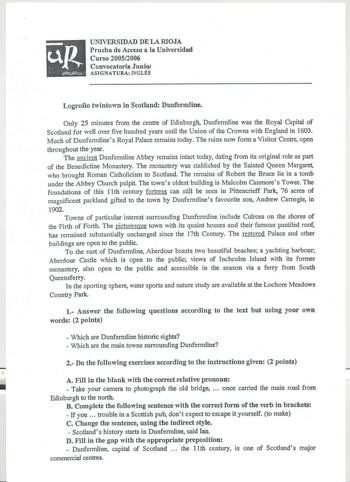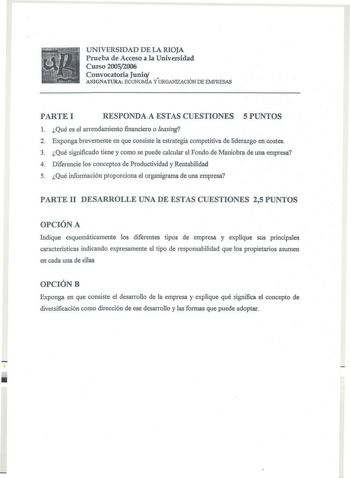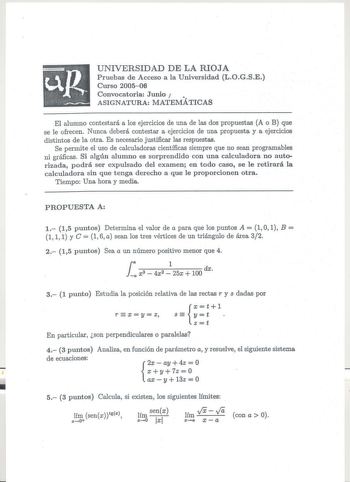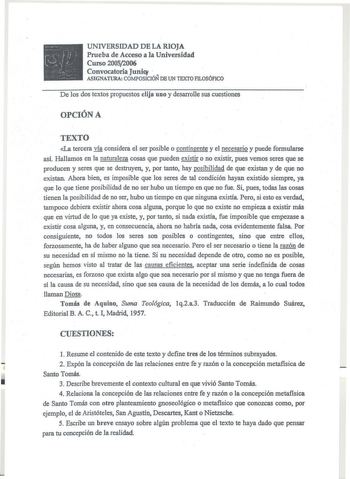Examen de Inglés de La Rioja (selectividad de 2006)

| Comunidad Autónoma | La Rioja |
|---|---|
| Asignatura | Inglés |
| Convocatoria | Ordinaria de 2006 |
| Fase | General |
Temas mencionados new_releases

Andrew Carnegie
Andrew Carnegie (but commonly or; November 25, 1835 – August 11, 1919) was a Scottish American industrialist who led the expansion of the American steel industry in the late 19th century, and is often identified as one of the richest people and Americans ever. He built a leadership role as a philanthropist for the United States and the British Empire. During the last 18 years of his life, he gave away to charities, foundations, and universities about $350 million (in 2015 share of GDP, $78.6 billion) – almost 90 percent of his fortune. His 1889 article proclaiming "The Gospel of Wealth" called…
Fuente: wikipedia.org
Robert the Bruce
Robert I (11 July 1274 – 7 June 1329), popularly known as Robert the Bruce (Medieval Gaelic: Roibert a Briuis; modern Scottish Gaelic: Raibeart Bruis; Norman French: Robert de Brus or Robert de Bruys; Early Scots: Robert Brus), was King of Scots from 1306 until his death in 1329. Robert was one of the most famous warriors of his generation, and eventually led Scotland during the First War of Scottish Independence against England. He fought successfully during his reign to regain Scotland's place as an independent country and is today revered in Scotland as a national hero.
Fuente: wikipedia.org
Firth of Forth
The Firth of Forth is the estuary (firth) of the River Forth in Scotland, where it flows into the North Sea, between Fife to the north and Lothian to the south. It was known as Bodotria in Roman times. In the Norse sagas it was known as the Myrkvifiörd.
Fuente: wikipedia.orgSouth Queensferry
Queensferry, also called South Queensferry or simply "The Ferry", is a town to the west of Edinburgh, Scotland, traditionally a royal burgh of West Lothian. It lies some ten miles to the north-west of Edinburgh city centre, on the shore of the Firth of Forth between the Forth Bridge and the Forth Road Bridge. The prefix South serves to distinguish it from North Queensferry, on the opposite shore of the Forth. Both towns derive their name from the ferry service established by Queen Margaret in the 11th century, which continued to operate at the town until 1964, when the Road Bridge was opened.
Fuente: wikipedia.org_in_Logroño.jpg?width=300)
Logroño
For the town in Ecuador, see Logroño, Ecuador. Logroño is a city in northern Spain, on the Ebro River. It is the capital of the province of La Rioja.
Fuente: wikipedia.org
Inchcolm
Inchcolm (from the Scottish Gaelic "Innis Choluim", meaning Columba's Island) is an island in the Firth of Forth in Scotland. It was repeatedly attacked by English raiders during the Wars of Scottish Independence, and was fortified during both World Wars to defend nearby Edinburgh. Inchcolm now attracts visitors to its former Augustine Abbey.
Fuente: wikipedia.org
Union of the Crowns
The Union of the Crowns was the accession of James VI, King of Scots, to the thrones of England and Ireland, and the consequential unification for some purposes (such as overseas diplomacy) of the three realms under a single monarch on 24 March 1603. The Union of Crowns followed the death of Elizabeth I of England — the last monarch of the Tudor dynasty, who was James's unmarried and childless first cousin twice removed.
Fuente: wikipedia.org
Aberdour Castle
Aberdour Castle is located in the village of Easter Aberdour, Fife, Scotland. Parts of the castle date from around 1200, making Aberdour one of the two oldest datable standing castles in Scotland, along with Castle Sween in Argyll, which was built at around the same time.
Fuente: wikipedia.org


